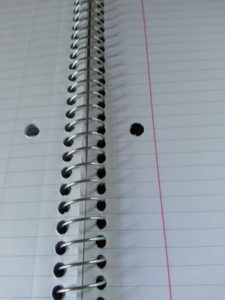
1956: a portrait of the writer as a ten-year-old girl: I’m a stocky, hearty kid, freckle-faced and blue-eyed, with brown hair that won’t sit down because of my cowlicks. This summer afternoon, fresh from the library, I’ve got a basket full of books and am pushing my dark blue Schwinn down Main Street.
Time to spend my allowance! Once inside the Five-and-Ten, I head for the stationary section; to me, that is the Five-and-Ten. Standing on worn old gray-brown floor boards, shifting back and forth from one foot to the other, I gaze at pile after pile of spiral notebooks. Oh, all those holes lined up in a row . . . the wire wound round and round through them. . . how pretty! The metallic gleam of those parallel coils. . .and those faint blue lines on the pages. Plus spiral notebooks flow from page to page like a book or a movie, right in front of me,. It’s as though the coils of wire could transmit themselves to my hand and make writing easy! It all makes me feel my thoughts are unlimited, like Peter Pan’s directions for getting to Neverland. “Second star to the right, and straight on ‘til morning!”
Glowing, pulsating words seem to hover above them all: Choose me! Use me!
Or is it magic?
Those spirals, I realize now, resemble those old fashioned hand-writing drills, repeating coils that were supposed to train the flow of your hand’s forward motion. But when I was ten, I was in the throes of learning to write connected script. I thought cursive (or longhand) was “the way grownups wrote”–and I wanted to be a grownup. To me, “real” writing felt–and looked–anything but comfortable.
Yet the adults around me seemed to simply turn on longhand whenever they needed, as though it were an adult language, even a kind of code. I’d watch my mother’s green fountain pen skim over the paper, creating a jaunty, chatty-looking script quite unlike the models I was supposed to copy. Even with a line guide under a blank sheet, Mommy’s letters didn’t touch the lines the way mine were supposed to. But her script was regular and controlled and appeared to me as an essential part of her personality. By contrast, my grandmother wrote slowly and laboriously, in a way I now think revealed how little formal schooling she had had. Essentially, Grammie drew every letter. Her ‘o’s’ and ‘a’s’, as well as the round sections of g’s and d’s and b’s, came out in a strawberry shape; scribing the cross stroke of an ‘x’ was a deliberate business. My father’s writing, in turn, was quick and vertical, almost stabby; it was connected printing rather than a flow of script.
It would be a long time before cursive writing became something I could naturally or freely do. Yet those spiral notebooks would accept me however I wrote, even if I didn’t write much at all; often I bought them, used a few pages, then realized how many more remained to be filled. Somehow, though, they always held out the promise: We’re here when you need us.
While forever conscious that I wasn’t a grownup, I was, however, blessedly free to explore woods and back yards. Yet I still had to operate under a lot of boundaries and rules. Grownups didn’t have to have babysitters when they went out at night. Grownups could wear shoes without shoelaces, pretty shoes with heels! Grownups could use our Magnavox record player for their LP records. Grownups could stay up late! They could talk or keep reading or having fun–while I had to go to bed. I hated bedtime, especially when I wanted to watch my father play badminton with the other neighborhood dads in the stretched-out twilights of June and July.
And then there was that eternal question, which all grownups seemed to ask. “What are you going to be when you grow up, Sally?” I’d answer, artist or teacher. This query seemed to mean, and to rub in the message: when you get serious and beyond this kid stage.
Long since an adult by this time, I still love deciding which notebook to buy, especially one to take on a trip. I notice that even in this computer-dominated age, spiral notebooks still sell, even in airport newstands. Not just user-friendly, they must appear imagination-friendly to others as well. Whenever I start a new one, I feel rich and happy: every page is pristine and awaits my pen.
What about blank books, you ask? They’re lovely—and useless. Their paper stretches ahead, yes, but they somehow feel finished already. Besides, often they’re so dauntingly beautiful that I feel ashamed to make mistakes, let alone cross anything out. And blank books are bound so they don’t lie flat and stretch out their arms, beckoning, Here, write on me. Most important of all, something is missing: that seductive, suggestive coil. That helix of free and boundless expression of ideas, a shooting star of trying things out. That wire that will festoon your thoughts into curves and garlands and webs of words, in total freedom, any time you want. The vertical coil of energy that stands ready to spring your thoughts and spiral them to the skies, on all those friendly open pages.
